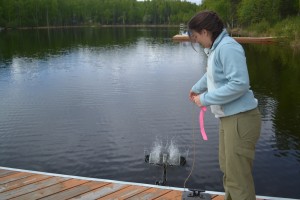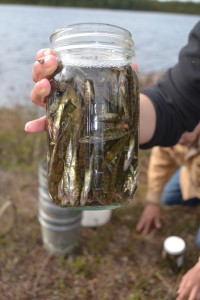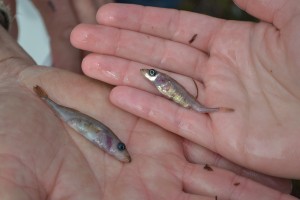Pickled Stickles: How to catch the stickleback of your dreams

Our second day in Alaska, we headed down to the Kenai (pronounced Key-nigh) Peninsula to collect some stickleback. The drive was stunning (as usual), and I couldn’t stop taking pictures of the mountains.

The first lake we stopped at was Solid Rock Lake, near Soldotna. Some of you might be thinking, “How do I catch a stickleback? Can I shoot it?” While there seem to be no shortage of guns in the grocery stores in Alaska, stickleback are too small to be of any use after being blown through by that pink camo rifle you’ve been looking for an excuse to buy.
Once at the lake, the first step is assembling the traps. These crafty traps snap together to create a structure into which the fish like to swim.
We then throw the traps off the shore, looking for a spot with a bit of cover that the stickleback might usually like to swim through, like short grasses or under a dock.

Very important at this step in the process is to avoid throwing the entire string attached to the trap into the water (Melissa…), or John will give you a very perplexed look.

Let traps sit for a few hours or overnight. Fish are fascinated by the new, flashy attraction in their neighborhood; they climb around and into the traps, yet find it much more difficult to get out than in.
The most stressful part of this system is the removal of the traps. My first day setting traps, after we had visited 7 lakes, John said he hoped we’d find some stickleback in the traps the next morning. While I knew field work could be unpredictable, I was flabbergasted that after we had put in over 70 traps and got plenty slimy in the process, we might not even find stickleback in the lakes.
Luckily, we found fish in nearly every trap the next day! We had captured anywhere from 300-1000 of our favorite threespined friends at each location, a very good day. After counting each trap’s haul, we preserved some of the fish and kept others alive to use in the lab.

The preserved fish are split into two groups: some go into jars of formalin and some go into jars of ethanol. Though from the same population, different types of information can be gathered by using these two different preservatives. Formalin will break down a fish’s DNA over time, but will preserve its organs, fins, eyes, etc. for study. Ethanol will preserve DNA longer, so a fish in this preservative could have its genes analyzed.
Genes and tissues like organs are intertwined, so they are both important to studies in the Foster-Baker lab. Enjoy a picture of two star-crossed fish lovers who both were infected by a parasite if you read that whole paragraph.

Though I worked in the lab this past semester, most of my project has been focused on analyzing video tapes of male stickleback in tanks. So while I’ve seen plenty of stickleback on a computer screen and preserved ones in a lab room, I confess that I had not seen a live one until this trip. While setting the traps, I couldn’t see any right off the shore and it was easy for me to become uncertain that stickleback really existed outside of our Clark facilities, much less that they would swim right into our seemingly unassuming traps. But that made pulling out a trap of gleaming three-inch long stickleback all the more rewarding. It’s probably how you felt when you reached the end of that paragraph on preservatives. Or maybe the end of this paragraph. But the quality of my writing aside, it completely linked together everything I had learned about these curious fish in the classroom, the laboratory, and the office together in one fishy swoop.
(For more on this, read Melissa’s charming post about her first siting here)
The final step in collecting stickleback in Alaska: load up the car, and reward yourself with a healthy dose of mountains!

Emma’s field biology word of the day: turbid (adj)
Definition: thick or opaque; deficienct of clarity or purity
Use in the field: “Resurrection Bay was quite turbid; there was a lot of sediment in the water.”
Source: Merriam-Webster 2013
